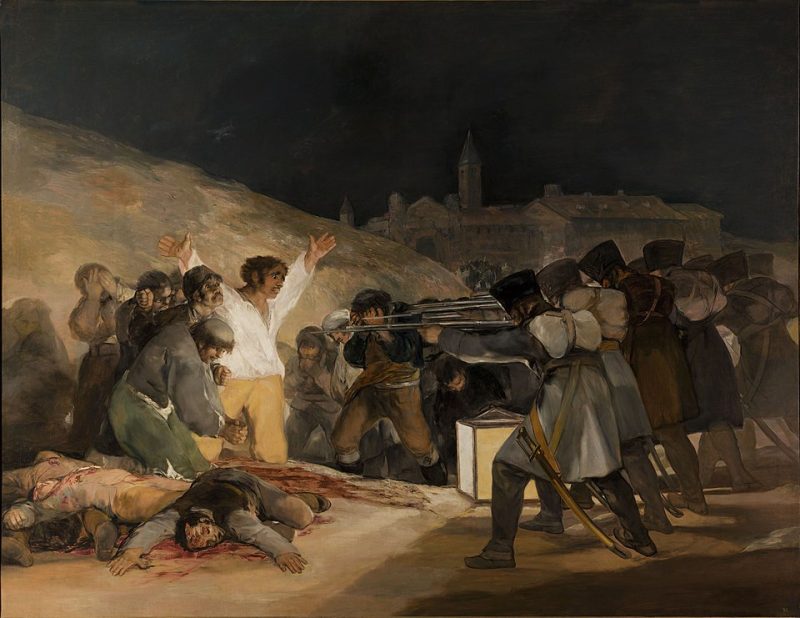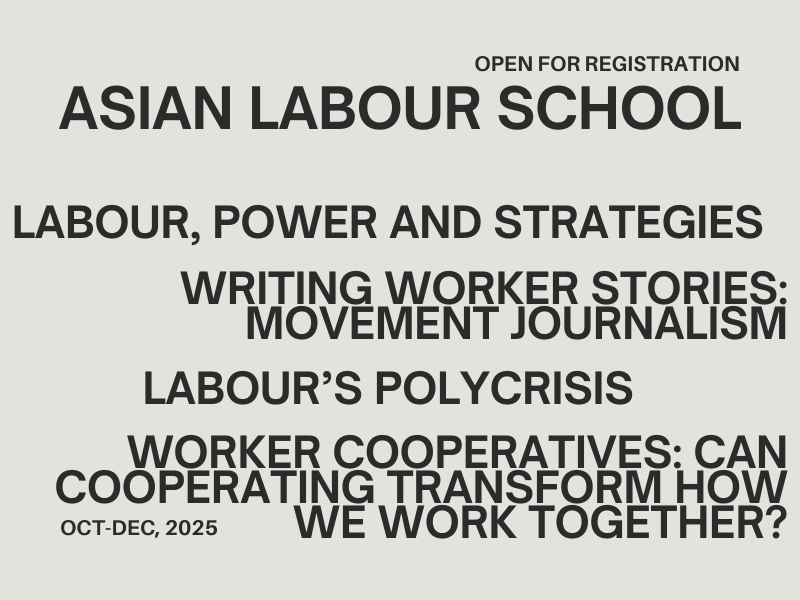Taiwan’s regime of temporary migrant labour was formalised as a kind of “guest worker” program in 1992, and it has been an important column of Taiwan’s racialised capitalism since.1 Treated differently from Taiwanese workers in many aspects, migrant workers have played a pivotal role in the care sector, manufacturing, the fisheries, construction, and agriculture. Recruited from Indonesia, the Philippines, Thailand, and Vietnam, they are brought to Taiwan for a limited period to perform low-waged, dirty, and demeaning work and form part of the particular class composition on the island.2
In the following paragraphs, we describe different phases of Taiwan’s regime of temporary migrant labor. This serves as a summary of the detailed timeline that is published along with this overview.3
Historical Context
After the rapid industrialisation process and Taiwan’s economic rise as one of the Asian Tiger States in the 1960s and 1970s, the island’s labour reservoir of domestic rural migrants and women workers dried up in the 1980s. At the time, Taiwan’s industrial workers demanded and won higher wages, and many of them refused to continue to do the “dirty” and low-waged work in factories, on construction sites, in households, on fishing vessels, and on farmers’ fields. A strike wave in Taiwan at the end of the 1980s, which was connected to the new possibilities for organising opened up by the democratisation process at the time, promised to further aggravate the shortage of “cheap” labour.
Taiwan’s capitalists reacted with several strategies. Besides economic upgrading and automation of labour processes, many relocated production facilities to the People’s Republic of China (PRC), the political enemy, without state permission. They aimed at tapping into the “cheap” labour force offered by the Chinese Communist Party (CCP) to foreign capitalist investors. And a part of Taiwan’s capitalists began hiring foreign workers who had entered Taiwan as tourists and had no work permit, most of them from the PRC or Southeast Asian countries.
First Phase
This can be seen as the first phase of Taiwan’s recent labour migration history, prior to the formalisation of the “guest worker” regime, from the mid-1980s until 1988. The entry and recruitment of migrant workers who often overstayed their tourist visas and who had no work permits was largely uncontrolled and driven by the capitalists’ desire to fill unskilled jobs and push wages down to increase their profits.
Second Phase
In the second phase from 1989 to 1991, Taiwan’s government started pilot projects and allowed the immigration of a contingent of migrant workers for public construction projects. The state regulation was the result of pressures from different sides: pressure from within the state administration to block the entry of migrant workers or, at least, control it tightly; pressure from labour unions to limit or ban labour migration; and pressure from Taiwanese capitalists to increase the supply of migrant labour through official channels.
Third Phase
In the third phase from 1992 to 1997, Taiwan’s government legalised and regulated the recruitment of temporary migrant workers from several Southeast Asian countries for unskilled, low-waged jobs in industries with particularly hard conditions only, thus institutionalising the racialised exploitation of migrant labour. Within a few years, legal migration increased substantially while illegal employment of migrants decreased, at least, according to official numbers (see graph 1). Then the curve of the number of migrant workers slowly flattened, while Taiwan’s government consolidated the “guest worker” regime according to capital needs. Beginning in the mid-1990s, migrant workers staged a range of struggles against unpaid wages, relocations, and closures, in part together with local workers. This happened in a period, when many Taiwanese companies relocated to the PRC (or Southeast Asia). Taiwanese unions, meanwhile, remained mostly critical of migrant workers as they saw them as “competitors” for local workers and their recruitment as the reason for rising unemployment.
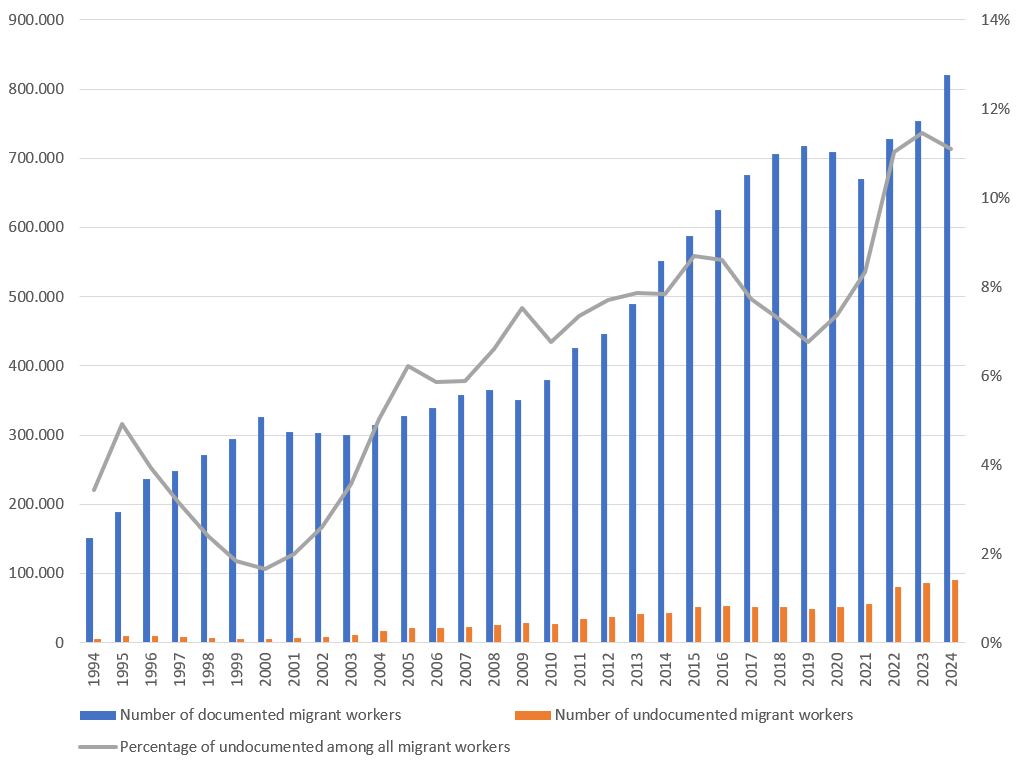
Graph 1: Official numbers of documented and of undocumented migrant workers plus the percentage of undocumented migrant workers among all migrant workers in Taiwan (1994–2024)4
Fourth Phase
At the beginning of the fourth phase from 1998 to 2007, the Asian Financial Crisis (1997–1998) had a negative effect on Taiwan’s economy (see the GDP development in graph 2) and prompted Taiwan’s government to slow down and adapt the recruitment of migrant workers from Southeast Asia and freeze the minimum wage, which most migrant workers in Taiwan earn. Events such as the mass brawl between Thai and Filipino workers in Mailiao 1999 and the riot of Thai workers in Kaohsiung 2005 caused local activists to set up support structures for migrant workers. Meanwhile, migrant workers themselves staged more protests and set up their own organisations to deal with the continuing problems inside and outside the workplaces.
Another form of labour migration accelerated in this phase, one that is usually not “temporary”: the influx of marriage migrants. It began in the 1980s, when mostly male farmers and workers from Taiwan looked for foreign women in “poorer” countries as wives doing reproductive labour. Marriage migration of mostly women from the PRC, followed by Vietnam and other Southeast Asian countries, increased in the 1990s, peaked in the first half of the 2000s and, subsequently, dropped and continued only on a lower level. The drop resulted from Taiwanese authorities’ increasing scrutiny over the commercial agencies that facilitated marriage migration as the authorities tried to prevent “fake” marriages. Besides, economic development in the women’s countries of origin had improved so that migrating to marry a farmer or worker in Taiwan lost attraction.5
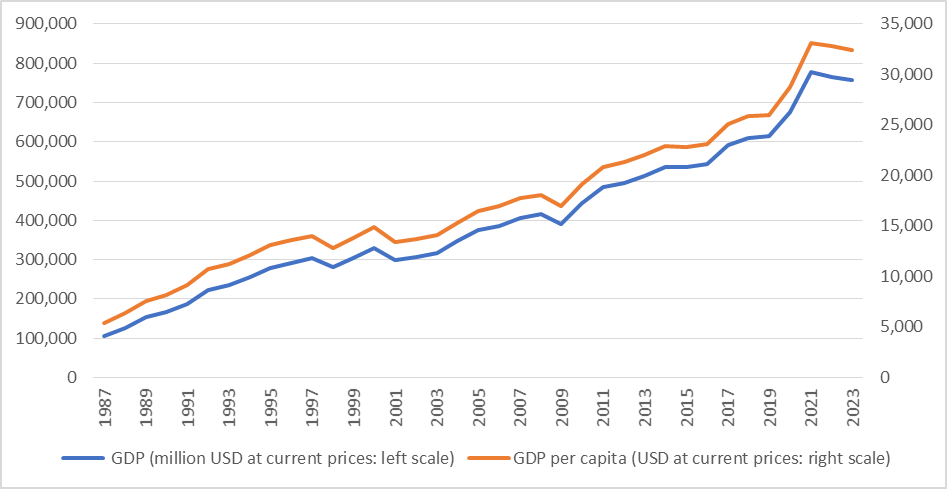
Graph 2: Taiwan’s GDP and GDP per capita (1987–2023).6
Fifth Phase
In the fifth phase from 2007 to 2019, with the improvement of the economic development after the global financial crisis (2007–2008; see graph 2), the government allowed the number of temporary migrant workers to increase substantially (see graph 1), and it increased the minimum wage again. However, the minimum wage stayed well below average wages for industrial labour (see graph 3). In addition, migrant domestic care workers were exempted from receiving the minimum wage (see graph 4). The government adapted the “guest worker” regime further by allowing migrant workers to stay longer, while keeping them under control of brokers, employers, and the state, and making sure their stay in Taiwan remained temporary.
Sixth Phase
The sixth phase from 2020 to 2022 encompasses the Covid-19 pandemic, when Taiwan’s economy was hit (see graph 2), while the government closed the border for new migrant workers and heavily restricted the mobility of migrant workers in Taiwan.
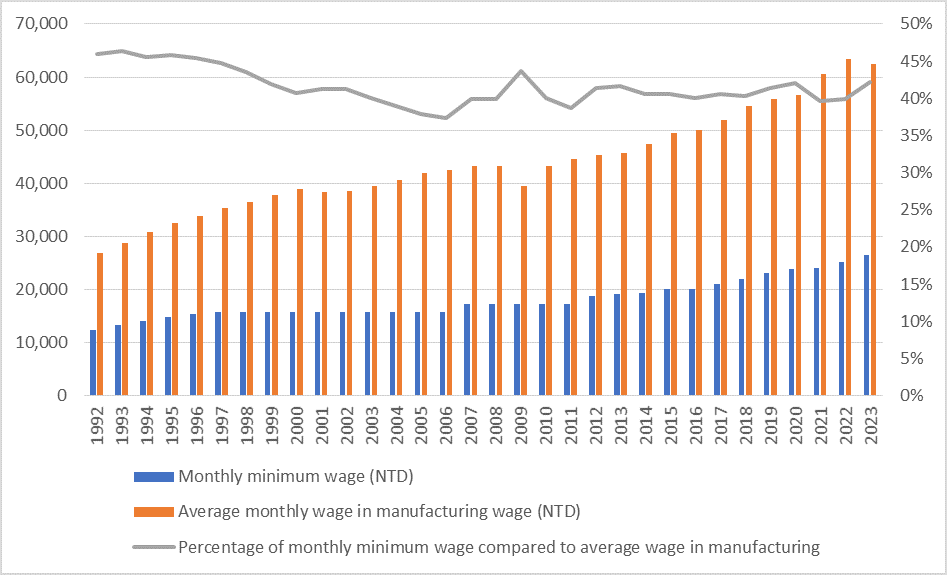
Graph 3: Monthly minimum wage, monthly average wage in manufacturing, and percentage of monthly minimum wage compared to monthly average manufacturing wage in Taiwan (1992–2023).7
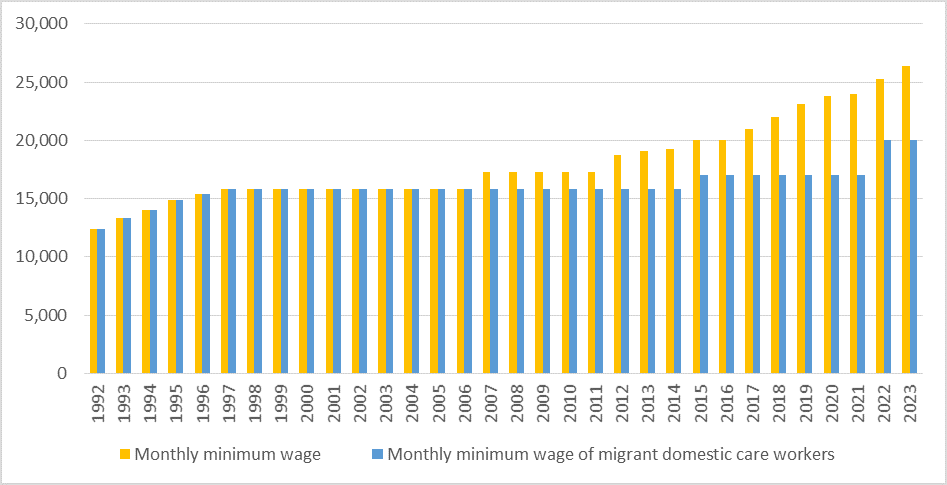
Graph 4: Monthly minimum wage, monthly minimum wage of migrant domestic care workers (1992–2023).8
Seventh Phase
The seventh and current phase since 2022 saw the opening of the borders for the recruitment of new migrant workers, an increase in numbers of both documented and undocumented migrant workers (see graph 1), and the introduction of a new scheme that allows migrant workers and their employers to apply for a more permanent status as so-called “medium-skilled” migrant workers in Taiwan. In 2023, the percentage of migrant workers in the total labour force grew to an unprecedented 7 percent (and rising; see graph 5).
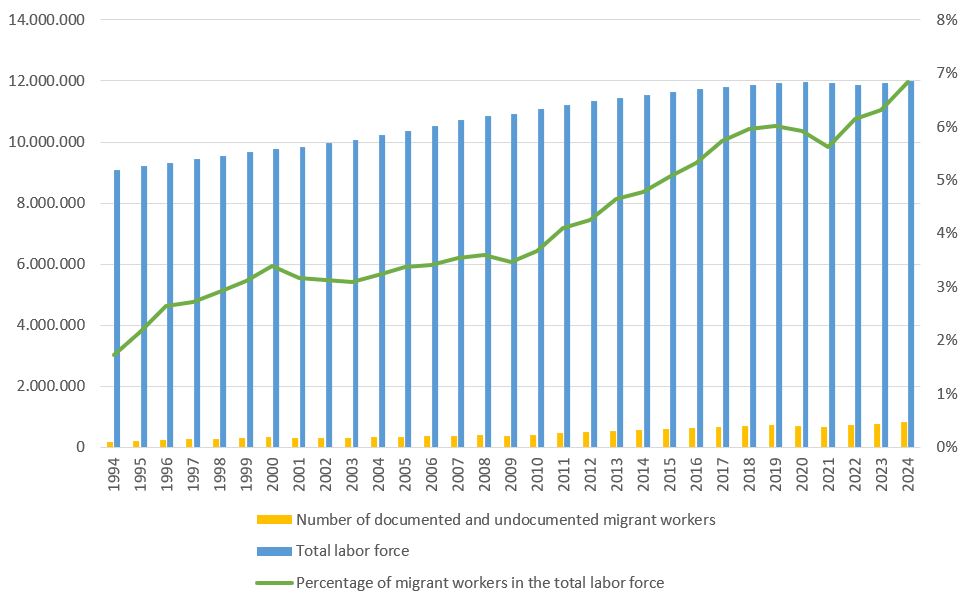
Graph 5: Number of documented and undocumented migrant workers, total labour force, and percentage of migrant workers in the total labour force in Taiwan (1994–2024).9
What comes next? Due to the labour shortages in Taiwan, aggravated by the very low fertility rate, Taiwan’s economy will most likely continue to need even larger numbers of migrant workers to keep its economy running. Meanwhile, due to the competition with other East Asian countries that have similar labour shortages, state and capital in Taiwan might find it increasingly hard to recruit enough migrant workers from Southeast Asia if they do not provide better conditions in terms of wages and status. This might create chances for migrant workers in Taiwan to improve their situation in the work places and in Taiwan’s society.
In sum, the past four decades saw continuous conflicts around the recruitment of migrant workers for Taiwan’s economy. Employers tried to mobilize the flexible migrant labour force they need even for longer than initially planned, different sections of the state fought over the provision of enough labour power and the control and regulation of migration and migrant workers, local unions tried to defend their local members’ interests and articulated that, at times, in openly racist forms, local supporters wanted to help migrant workers in their difficult situation (often focusing more on welfare provision than on questioning systematic racism), and migrant workers tried to deal with the exploitation, precarity, and control they have faced and have sought to improve their conditions.
Literature
Dinkelaker, Samia, and Ralf Ruckus. 2023a. “Indonesian Migrant Labor in Taiwan’s Racialized Capitalism. Preliminary Notes on a Research Project,” positions politics, March 29: https://positionspolitics.org/
_________. 2023b. “Sweatshops and Assembly Halls. The Class Composition of Indonesian Migrant Workers in Taiwan’s Manufacturing Industry,” Asian Labour Review, November 30: https://labourreview.org/
_________. 2025. “Taiwan’s Regime of Temporary Migrant Labour: Timeline of Changes,” Asian Labour Review, July 7: https://labourreview.org/a-timeline-of-taiwan-regime-of-temporary-migrant-labour.
Hsia Hsiao-Chuan. 2004. “Internationalization of Capital and the Trade in Asian Women. The Case of ‘Foreign Brides’ in Taiwan.” In: Women and Globalization, edited by Delia D. Aguilar and Anne E. Lacsamana. New York: Humanity Books.
Ministry of Labor 2024. “Labor Statistics”: https://statfy.mol.gov.tw/
Ou Ya-mei. 2024. “Policies Related to the Adaptation of New Immigrants and Their Children,” September 14, Taiwan Immigrants’ Global News Network: https://news.immigration.gov.
Qian Zhenchao and Tsai Ming-Chang. 2022. “Relative Economic Position and Female Marriage Migration: Marrying Men in Taiwan Across Borders and Boundaries,” Population Research and Policy Review, pp. 1451–1470.
Taiwan’s Regime of Temporary Migrant Labour: Timeline of Changes
- Dinkelaker and Ruckus 2023a
- See our earlier account on this class composition and the role of Indonesia migrant workers in Taiwan on the Asian Labour Review website: Dinkelaker and Ruckus 2023b
- Dinkelaker and Ruckus 2025
- Ministry of Labour 2024
- Qian and Tsai 2022. Also see Hsia 2004. The aggregate number of marriage migrants in Taiwan has, nevertheless, been impressive. In July 2024, their number stood at 600,000 (Ou 2024).
- National Statistics, Republic of China (Taiwan) 2024
- Ministry of Labour 2024
- Ibid.
- Ibid.

